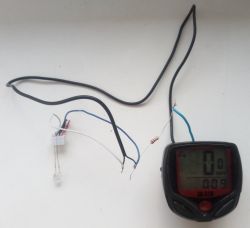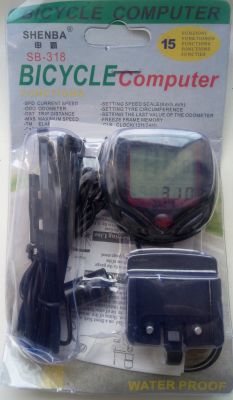Optical wattmeter for £10
 .
.
I prove that it is possible to measure instantaneous power and watt-hours consumed with the cheapest bicycle meter, a phototransistor and a resistor
You only need to:
- take the plus battery out of the meter
- cut the reed switch from the cable and identify which of the two wires is the minus of the battery
- connect the emitter of the phototransistor to minus and the collector to the return wire
- connect a resistor between the positive and the collector of the photo transistor
- connect the phototransistor to the LED in the energy meter
I used a Shenb SB-318 counter ($2), a FT06-M phototransistor (£1.20) and a 10kΩ resistor.


 .
.
And here's a video showing how it works when an approximately two-kilowatt kettle finishes boiling water:
The energy meter does 2,500 pulses per kilowatt hour, so I've set a circle circumference of 4,000 mm, so the result of 21.1 km/h means an intake of 2110 W.
You can see that with each pulse, 4 metres of distance is gained, and the 1,580 km gained is 0.158 kWh.
Unfortunately, the bike meter does not show speeds of less than ~3 km/h, which translates to 300 W. An energy meter doing more imp/kWh would have been better suited.
Finally, I'm glad to have met @efi222's challenge from https://www.elektroda.pl/rtvforum/topic4067036.html#21167617



Comments
A small correction: a colleague did not make a wattmeter. This chip does not measure watts. It is at most an indicator of how fast a diode is pulsing. The fact that it was a diode from a wattmeter makes... [Read more]
Interesting patent. But don't electronic meters show these values on the display? Another thing is that the meter can be reset and measure, for example, the daily energy consumption. [Read more]
Not a bad imagination and it's a very out-of-the-box approach. I find it hard to imagine the reaction when someone hears the conversation: 'the power consumption of this device reaches 5km/h, while... [Read more]
In my opinion, it changes everything :) . The circuit consists of 2 components. A resistor polarises the phototransistor, and this converts the light pulses into short circuits. And that's as much... [Read more]
Congratulations on realising the idea :D . . I have to admit I'm surprised.... :) [Read more]
You just forgot to add that these bike counters require the circumference of the wheel according to which they change their readings of speed and distance travelled. Have you thought about calibrating... [Read more]
Fun and interesting, but a bit spoiled by the price of the bike meter - $2. For that much you can already get a WiFi programmable module with ESP8266 in China, and it is also very cheap in our country: ... [Read more]
. A mini project like this was done a year ago. https://www.elektroda.pl/rtvforum/topic4067036.html [Read more]
. Unfortunately, but it looks like what the meter displays depends on how it's configured: https://www.elektroda.pl/rtvforum/topic3656022.html [Read more]
I did not forget: . I calibrate it so that the kilometres correspond to a decimal multiple of the watts. The electric meter just happens to have 2500 imp/kWh. So I set wheel circumference = 4000 mm,... [Read more]
These cheap bicycle counters have a relatively inaccurate internal (quartz) frequency reference. I infer this from the fact that I have two such counters and after a month they show a considerable deviation... [Read more]
With this inaccurate time or there frequency standard it is true. The manufacturer does not specify the accuracy, because it is a toy and not a measuring instrument :) . But - the accuracy of the time... [Read more]
. Well, yes, you are right, the measurement of energy only involves adding a fixed number of units, derived from the value of the "circumference of the circle", every single pulse coming from the photodetector. Only... [Read more]
The accuracy of the quartz is small beer. Maruda mode ON: 1. it is not even a substitute for a wattmeter, because it does not indicate power, but energy/work. After all, a wattmeter indicates the instantaneous... [Read more]
Not true :) Have you watched the video? I explained underneath it that: The bike meter indicates power (in hundreds of watts) and underneath energy/work (in tenths of a kilowatt hour - you may... [Read more]
Unfounded fears, as everything is correct. A bicycle speedometer shows speed as the derivative of distance relative to time. Here it presents power as the derivative of energy relative to time. [Read more]
I like the idea, if the author has established the circumference of the circle properly then the values will be correct, just the units strange :D [Read more]
This bike meter, from what I can see in the manual, allows you to enter wheel circumference from 0mm all the way up to 9999mm. Have you perhaps checked what would happen if you entered twice the value... [Read more]
I apologise to all those who have written here but out of curiosity I have carried out all the tests (by taping the meter from my daughter's bike) and unfortunately it is total nonsense . the fastest test... [Read more]